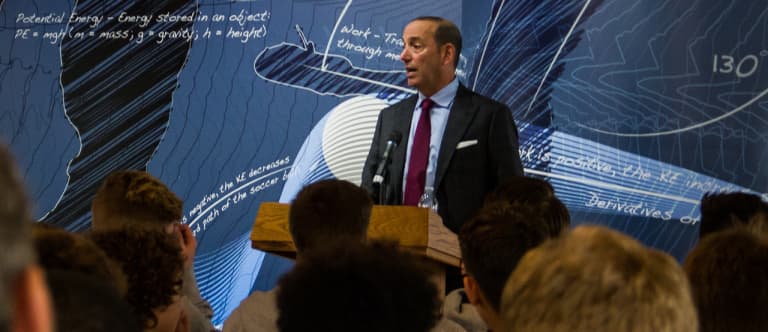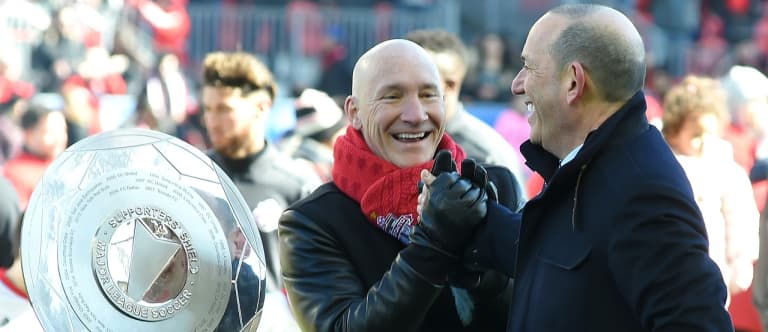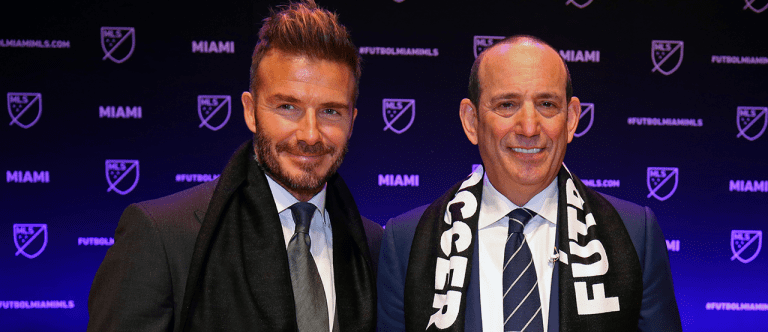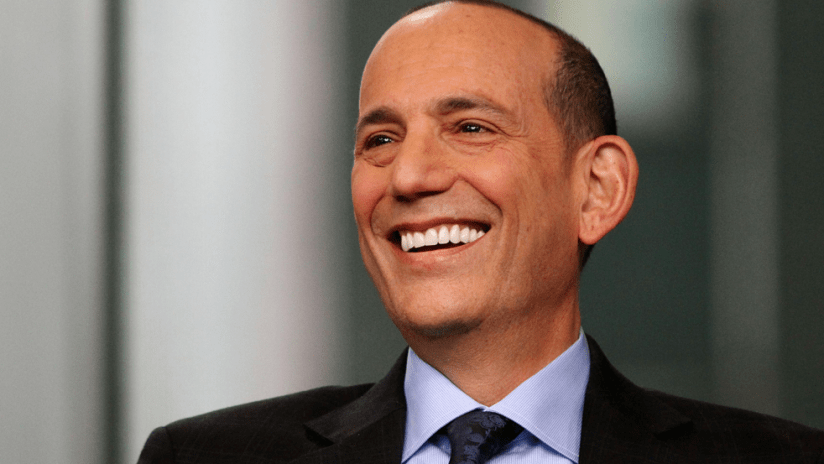FRISCO, Texas – On Saturday afternoon MLS Commissioner Don Garber was officially inducted into the National Soccer Hall of Fame as part of a 2018 class that also includes US women’s national team legends Cindy Parlow Cone and Tiffeny Milbrett, former U.S. Soccer president Dr. Bob Contiguglia and US men’s national team star (turned New England Revolution head coach) Brad Friedel.
It’s a major milestone in the lives of all five individuals – and one that’s particularly special as it coincides with the debut of the Hall’s new digs in the gorgeously remodeled south end of Toyota Stadium, home of FC Dallas, which underwent a $55 million renovation to reach this point.
It’s also another hefty accomplishment for Garber, who next year marks his 20th anniversary at the helm of MLS, a league that today scarcely resembles the embattled entity he arrived at in 1999.
Garber’s road to the Hall of Fame in many ways mirrors MLS’s long climb to stability and prosperity. Here’s a few of the key moments along the way.
2001: MLS contracts Florida teams, founds SUM
Already short on owner/investors and losing millions of dollars, the fledgling league suffered a heavy blow when the terrorist attacks of Sept. 11, 2001 devastated the United States and brought on a recession. That December, Garber gathered owners at the Anschutz Ranch in rural Colorado to plot a course to survival.
The painful decision was made to shutter the struggling Tampa Bay Mutiny and Miami Fusion franchises, removing the league from the soccer-mad Sunshine State for what would turn out to be more than a decade, an absence finally mended when Orlando City SC entered the league in 2015.
Almost lost in the reverberations of that two-team contraction was a visionary move that wrought huge changes in the North American soccer landscape: The creation of Soccer United Marketing, the media company that consolidated the commercial rights for MLS, US Soccer and other top soccer properties under one umbrella, starting with the acquisition of the English-language broadcasting rights to the 2002 and 2006 World Cups in partnership with ESPN.
SUM would rapidly grow into a powerful engine for North American soccer’s growth, bringing order to a chaotic landscape and undergirding MLS’s future growth.
2003: StubHub Center opens, sparking MLS’s stadium boom
Columbus Crew Stadium, today known as MAPFRE Stadium, opened in 1999 and will always command a special place in history as the league’s first soccer-specific facility. But with existential questions still hanging over MLS’s head as it entered the new century, the debut of the LA Galaxy’s home in Carson, California was just as much of a watershed moment.
Tagged the Home Depot Center when it first opened, the sun-splashed venue and its adjacent training facilities immediately became the model for MLS teams seeking a place of their own. FCD's Toyota Stadium came online two years later. Then the Chicago Fire's Toyota Park, then Dick's Sporting Goods Park in Colorado and Toronto’s BMO Field. Rio Tinto Stadium and Stade Saputo came online a year after that, and the process still continues to this day.
All that real estate made it clear to the North American game’s many doubters that professional soccer was here to stay. Garber will enter the HOF as a “builder,” and the category is particularly apt for him – he’s led the way in constructing the houses where MLS lives. His place in the Hall will be marked not by a jersey or boots, but a shovel and hardhat.
2006: MLS launches league-wide youth academy program

Garber speaks at Philadelphia Union academy event. | Courtesy of Philadelphia Union
Today we tend to take it for granted that MLS teams can and should grow their own talent and guide players along a pathway from youth soccer to the professional level. The formalized version of that began less than 12 years ago, however: at MLS Cup 2006, when Garber announced the league-wide initiative that would become the Homegrown Player system.
The HGP process has become a pivotal means by which smaller, less wealthy teams can compete against richer competitors in bigger markets. It’s also helped to provide more opportunities for young prospects, and fuels the pipelines of talent that feed the US and Canadian national teams, and even those of smaller Concacaf neighbors as well.
Clubs like the New York Red Bulls and Real Salt Lake are not only churning out quality talent, they’re inculcating them with their own specific styles of play, and giving fans the chance to cheer on local products who understand what it means to represent their community on the field.
2007: Toronto FC debuts, heralding Canada’s arrival in MLS

TFC president Bill Manning (left) with Garber at a celebration over the 2017 Supporters' Shield win. | USA Today Images
Younger viewers may know TFC mainly as the juggernaut that beat all comers in 2017. Longtime MLS observers, however, recall just how influential the Reds’ expansion debut turned out to be off the pitch.
Toronto marked the league’s first foray across the border. And even as the team struggled on the field, their fans packed into their lakeside stadium to cheer on the home team, providing colorful support and drawing attention to Canada’s passionate soccer communities. The rapid growth of TFC’s devoted supporters’ groups and the culture that flourished around them provided a vivid case study for Toronto’s US counterparts.
Well-loved lower-division sides in Montreal and Vancouver were subsequently welcomed into MLS, and the league has benefited greatly from its northern expansion – which also helped foster the ties that led to the successful joint North American bid to host the 2026 World Cup.
2007: David Beckham signs with the Galaxy, raising the curtain on the DP era

Beckham and Garber earlier this year. | USA Today Images
Soccer-specific stadiums and commercial-rights alliances are sensible vehicles for stability and growth. But pro sports always needs style as well as substance, and one of the most famous faces in the history of world soccer arrived at just the right time in Garber’s tenure to speed that along.
Luring a global icon like Beckham away from mighty Real Madrid was a coup of unprecedented proportions. And despite a bumpy start to his life in MLS – the 2007 Galaxy were fairly woeful on the field, and as it turned out, pretty dysfunctional off it – the investment in Beckham reaped myriad long-term benefits.
From then on, big-name players looked at MLS differently. Many grew to contemplate it as a possible destination, with the “Designated Player” rule making it possible for teams to offer them contracts more on par with those available in major leagues in Europe and South America. In the process, MLS’s quality and visibility began to rise, and the league sustained that trajectory with subsequent injections of spending like GAM, TAM and the like.
And of course, Beckham – who eventually helped LA become a dynasty, winning two MLS Cups and two Supporters’ Shields – is back on board today, as a part-owner of expansion side Inter Miami CF.










